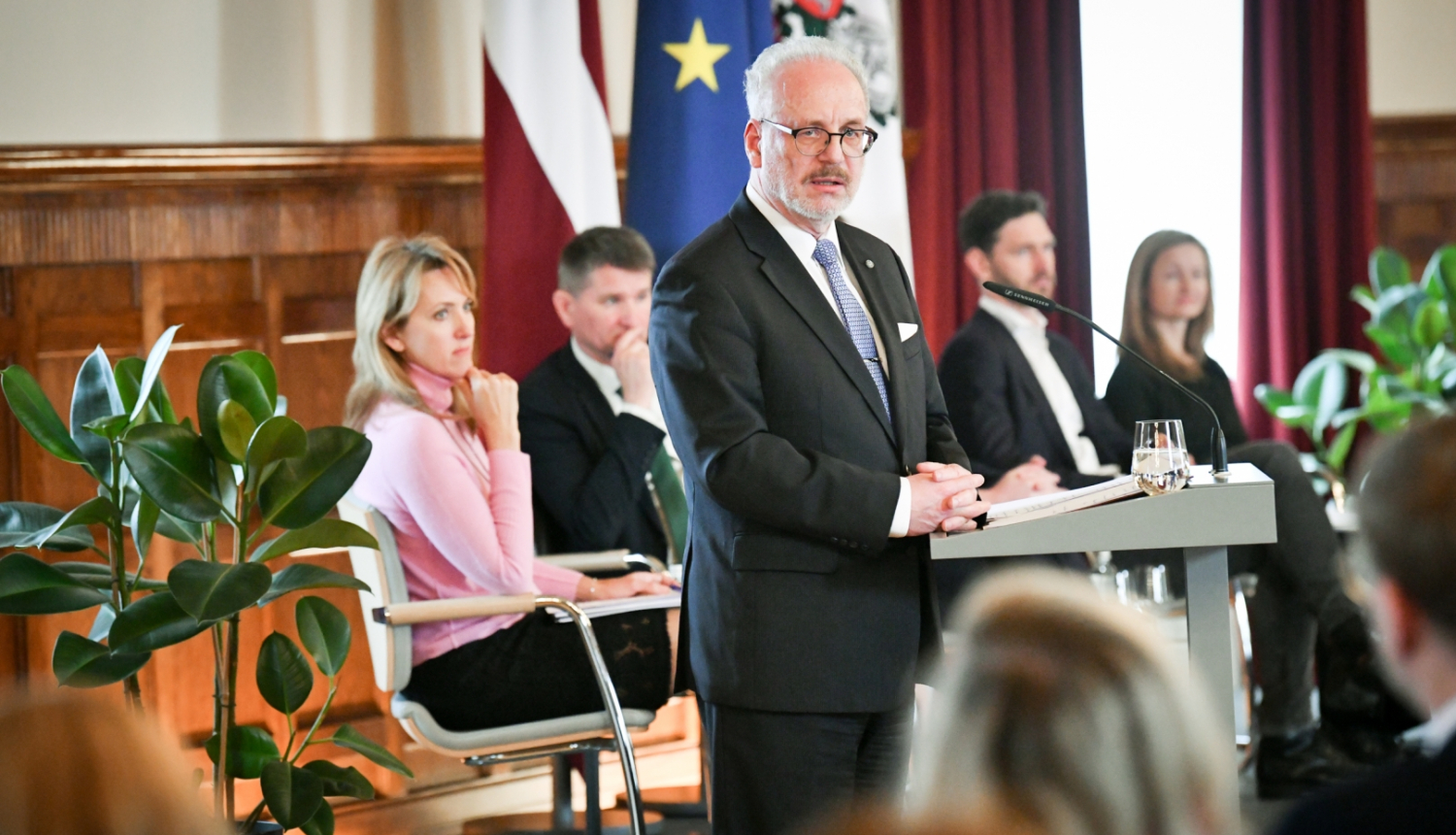Dear participants!
I
The first decade of this century is a technological revolution, as technology has become accessible to most people. The capacity of technology has grown at an unimaginable speed.
We have "moved" a significant part of our lives into the digital world - on mobile phones and computers, but we started with music and iPods. Over the last decade, we have also moved to the digitisation of documents, and people's communication with public administration is being digitised.
The Latvian public administration has digitised a relatively large number of public administration services. The fact that 85% of all internet users in Latvia use e-government services, compared to the EU average of 64%, illustrates the progress made so far. We are at the forefront in this area.
At the same time, digitisation is also taking place in the private - commercial - sector, where production processes, internal and external communication of companies are being digitised. E-commerce, or the purchase of goods and services on the internet, has also developed.
I would like to emphasize that extensive digitisation is only the first step towards digital transformation. Digitalisation is not yet digital transformation.
In the digitalisation phase, digital tools are used as ancillary tools to improve the effectiveness of traditional communication. However, the content and the structure of communication are the same.
We are still in the digitalisation phase. Digitalisation has different levels - higher and lower. And we have reached a relatively high level of digitisation (fast internet, accessible devices, lots of digitised information).
However, there is a feeling that we have not exploited the full potential of digitisation. That is why we will talk about the possibilities of digitisation in this discussion. In particular, we will not focus on the entire field of digitisation, but only on digitisation in the public sector.
II
The purpose of digitization of the public sector is to save financial and natural resources, to find innovative solutions. But the main reason why we are doing this is to make it easier and more convenient for people to communicate with the state. Whether this is the case in all cases is a big question mark. That is what I am going to talk about.
So, I can say that the conditions for digitisation in Latvia are very good. A non-targeted policy has produced good results. But that alone will not be enough at this stage.
Two years ago, here at Riga Castle, we already met once and discussed Latvia's digital priorities at that time. They were related to the use of the European Recovery Fund - 20% of the total funding, around €330 million, was to be earmarked for digital transformation under this fund.
On 7 July 2021, the Digital transformation guidelines for the next seven years were also approved. The guidelines are a lengthy document, written in a typical bureaucratic language with 200 pages of verbiage. It is difficult to see the main thrusts in this document, but I think that everything we need is there. It is just a matter of finding it and working out how to achieve it.
At the same time, the European Structural Funds' contribution is planned for the same seven-year period, with a strong focus on achieving the objectives of Europe’s Digital Decade.
The Ministry of Finance estimates that the total support from the European Union for all digital transformation in Latvia is around €1 billion. This is without our own contribution.
III
What should be the national digital policy?
The more sophisticated and powerful technologies become, the more they go beyond the logic of their own system. Therefore, the more powerful and advanced the technology, the more extensive the digital policy must be to deal with it.
The digital policy has to be more intensive, more regulatory, “denser”.
It is time for the government, Saeima, for all of us, to think about the regulation of digital technologies. The usual instrument is, of course, laws and other forms of legislation. Here, however, we should also bear in mind that lawyers also need to be innovative. Because traditionally, the effect of the laws we have adopted ends at the Lithuanian border, while digital technologies go beyond borders.
This digital policy must cover three main areas. Firstly, protecting people from the negative effects of technology. Secondly, preventing the wasteful consumption of public resources - so technology in the sake of technology. This is the typical approach of engineers, programmers who want to go further and further to improve the software. But the question is, do we need it? This moment of evaluation needs to be developed. And thirdly, exploiting the potential of digitalisation.
IV
Let me explain a little about these three aspects.
The first is protecting people. Like almost all technologies, digital technology is a typical dual use technology - it can be used for good and bad purposes. Biological weapons are one example. Their research is banned. This is one example of how the state and society have assessed that it is too dangerous. It is no longer a dual-use technology, but a technology that can be used only for bad purposes.
It is, of course, different with digital technologies. They have good and bad consequences. Moreover, these consequences are, for the most part, unintentional. The bad results and consequences come later as unintended side effects.
Those of you who work in sociology are familiar with the theory of the risk society, the so-called second modernity, in which we are now fully immersed. Its development is largely driven by the elimination of the side effects of previous developments. We have created unintended side effects with previous technologies. Now we are creating new technologies to prevent these side effects. For example, cars, which were invented in the 19th century when nobody thought about the climate. Now we see that there is one “small” downside, and so we invest a lot of resources to tackle this unintended side-effect.
Any digital technology can cause unintended side effects. It is the job of programmers and engineers to try to see them, but it is even more the job of politics and society to try to see the side effects that we do not want from this technology. It is, therefore, a political task to protect people from the negative side effects of digitisation.
Some examples. One of them is well known – the issue of privacy. We are all familiar with Article 96 of the Constitution, which defines privacy. Article 96 was adopted in 1998, when these side effects of digitisation did not exist, and of course it worked. But now it does not really work anymore.
We are now in a state of awareness where it is no longer just a question of privacy but of democracy. For example, there were complaints recently in Latvia about Facebook censoring the Internet. It is, of course, not neutral censorship. Every censor has certain ideas about what can and cannot be done. So far, such cases have been decided by the court. That is not the case with Internet censorship. And here, from a human rights and democratic point of view, we see a regression – censors censoring public opinion. And they are not necessarily Latvian censors.
Then information warfare, or rather cognitive warfare - the manipulation of human perception.
I do not want to go deeper into these issues, but to raise them because they are the subject of digital policy. The issue of data security. And, of course, criminal activity, which is a fairly well-known issue. How to prevent them is a matter of both technique and politics.
One interesting thought. If the state makes it compulsory for people to use digital technology in cooperation with the state, and if there is some mistake, then the state must be held responsible. Let us imagine a situation: many people have to submit their declarations to the State Revenue Service, the last day of the deadline has arrived, and it is not possible to submit the declaration because there is a failure on the website. Will I be subject to the legal consequences of not submitting the declaration on time? Do I have proof that the website was unreachable? In these matters, the state must ensure the security of citizens. In the above case, it should be possible to obtain printed proof to show that the necessary action could not be taken. So, the risks that are associated with going online and where the state imposes obligations to take risks through this digital online channels.
Another central sector that we will be talking about today is communication between the state and the citizen. I would like to add here about digital design, which is also a constitutional issue.
The Constitution states that citizens must be able to communicate with the state and the state must be able to communicate with the people. And they must understand each other. And that is the intellectual moment.
V
About waste of human and public resources.
We have already talked a lot about data connectivity. There is a lot of data in the public domain that are not sufficiently connected. It seems that the logic should be that all public authorities' data are compatible, and all public authorities and public servants can use all data. That, of course, would not be right. Therefore, a second principle should be built on this basic principle - only where it is necessary and permissible. It would not make sense, for example, if every official in the Ministry of Health had access to all the data in the Ministry of Defence. In the interests of the state and of individuals, these restrictions should be imposed.
We have been talking about expediency for some 20 years. About “one-stop shop”. I think that if we sorted out the national data system, it would be quite simple to have this one-stop shop.
People's skills are very important in exploiting potential. All sorts of opportunities and courses are available to improve them.
Also, accessibility. In the project “Computer for every child”, we found that not every child has a computer. How can we move forward with digital literacy?
VI
Finally, digital governance. I think Latvians have one complex. And that is that we often don't understand that in order to address an issue in a sustainable way, a relevant institution is needed. Otherwise, it is a question of enthusiasm, colleagues!
And very many of these cannot be questions of enthusiasm. I had a proposal for appointing a Minister of State for Digitalisation at the Ministry of Environmental Protection and Regional Development, who is responsible for everything that we are going to talk about today. I would suggest that the Ministry of Environmental Protection and Regional Development be renamed the Ministry of Environmental Protection, Regional Development and Digitisation.
I recently had a meeting with the Rwandan Minister for Digitisation, where we discussed very meaningful, interesting, and progressive ideas. In Rwanda, digitisation issues are handled by a ministry that operates under a digitisation policy.
VII
Everything said so far is small potatoes compared to the big, global issues of digitisation. In Latvia, this is not usually thought about. As I said before, after digitalisation, the next stage is digital transformation, where people adapt themselves to digital technologies. They ask about digital technologies, and I am not talking about production but about a social activity to take decisions.
Last week I spoke at the 23rd German Congress of Judges and Prosecutors, where one of the topics was "To what extent can the courts use digital tools?" There are, of course, programmes that offer the judge a draft judgment. The question then arises, is there a need for a judge, or can we delegate the adjudication? And therefore, can we delegate decision-making in public administration to artificial intelligence?
We need to have our own position on the big digital policy issues at the national level and also at the level of the European Union.





